Shannon Szabados breaking through barriers with SPHL’s Cottonmouths
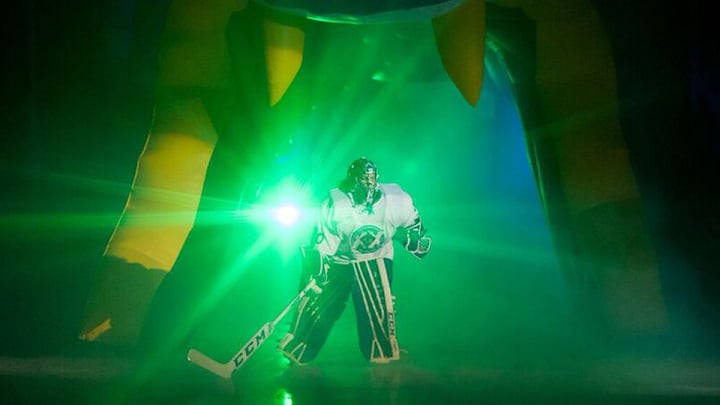
Tucked between the Chattahoochee River to the west and Fort Benning to the east and south sits Columbus, Georgia. Here in this Bible Belt city with its small-town feel and farmers’ markets every Saturday over on Broadway, you’re greeted with a “Good morning.” Handshakes are replaced by hugs.
It’s the kind of southern community where you can plant your roots and raise a family. Insurance provider Aflac is one of the corporations that has its headquarters here. There’s also plenty to do and see—including men’s pro ice hockey. If you’re not from around here, you might not know about the Columbus Cottonmouths of the Southern Professional Hockey League, but chances are you’ve heard about their Olympic gold medal-winning goalie or even seen her play.
That’s right, her.
Pride, Canadiennes skate to tie in first Outdoor Women’s Classic
Her name is Shannon Szabados. She’s the one who backstopped Team Canada to gold at the 2010 Vancouver and 2014 Sochi Winter Games.
Cottonmouths head coach and general manager Jerome Bechard chuckles when he thinks about if he ever imagined having someone like Szabados play for him in the SPHL.
“Nope,” he says. “Not in my wildest dreams.”
So how did the Canadian phenomenon wind up in Georgia? Well, it’s a journey that’s included countless wins and unforgettable memories on the world’s largest stages, but also years of harassment and gender discrimination.
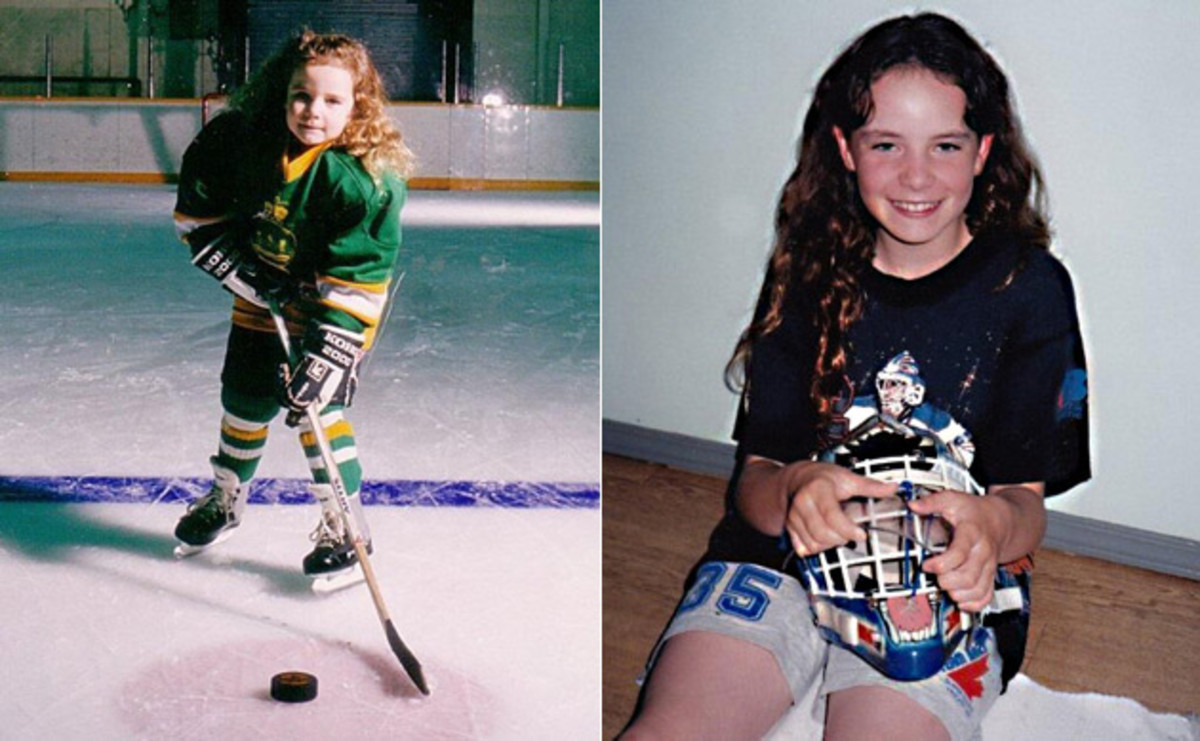
A native of Edmonton, Szabados grew up watching hockey on TV and quickly developed a love for the game and her hometown Oilers from her father’s lap. By age five, she was playing.
“She was just a go-getter,” Gary Szabados, 53, says about his daughter’s first year on the ice, adding that she wasn’t out there to make snow angels like her peers.
With modest early goals and big plans, NWHL has reason for hope
The soon-to-be goalie found her way to the net by age eight. Early on, there weren’t girls-only teams in her area, so she, and anyone else who wanted to, played with boys. As time went on, though, the other girls stopped turning out. But Szabados didn’t think about leaving. Instead, she opted to stick with what was familiar.
Before she tried out for bantam hockey at 13, her mother and father sat her down at the kitchen table. The level of play was only going to get tougher, they told her. However, if she wanted to continue playing hockey with boys, her parents would have her back.
Szabados understood. Advancing through higher levels of the sport meant more sacrifices, more commitment. She was ready. She didn’t want to switch to the girls’ game.
But the conversation wasn’t just about dedication and advancement. Her parents told her that the way she was treated would get worse. What Gary Szabados didn’t realize at the time was just how worse it would get.
“She put up with a lot of bull----,” he says, calling some of the group that discriminated against his daughter over the years as “good ol’ boys.”
“The number one thing that was constant from all these good ol’ boys is ‘She’s taking a boy’s job,’” he says. “If you took some of the stuff that was said on the ice and by the opposing coaches and by the fans, you’re talking major sexual harassment there. Most of it, you could tell what was going on. You couldn’t hear it all, but most of it you could see and hear.”
• PREWITT: Playing for your hometown NHL team has its special headaches
Throughout her formative years, Szabados never had any issues with teammates. In the dressing room, accommodations were put in place so she’d get privacy when needed but, at the same time, she wouldn’t get shut off from everyone else. But Szabados says parents singled her out during her early teenage years. She thinks it’s because at that age parents feel their sons’ futures are in the NHL. They didn’t want a girl dashing those dreams.
The earliest incident Gary recalls during a mid-December conversation with a reporter at his house in Edmonton dates back to when his daughter was trying out for a team at the midget (13-14) AAA bantam level. At some point, the coach had a meeting with a team executive, Gary says he was later told. The executive didn’t mince words. Adding Szabados was a waste of a roster spot. She wasn’t going anywhere in hockey. A male goalie should be picked. If the coach didn’t and instead decided to go with Szabados, he would be at risk of ending up on the executive’s bad side.
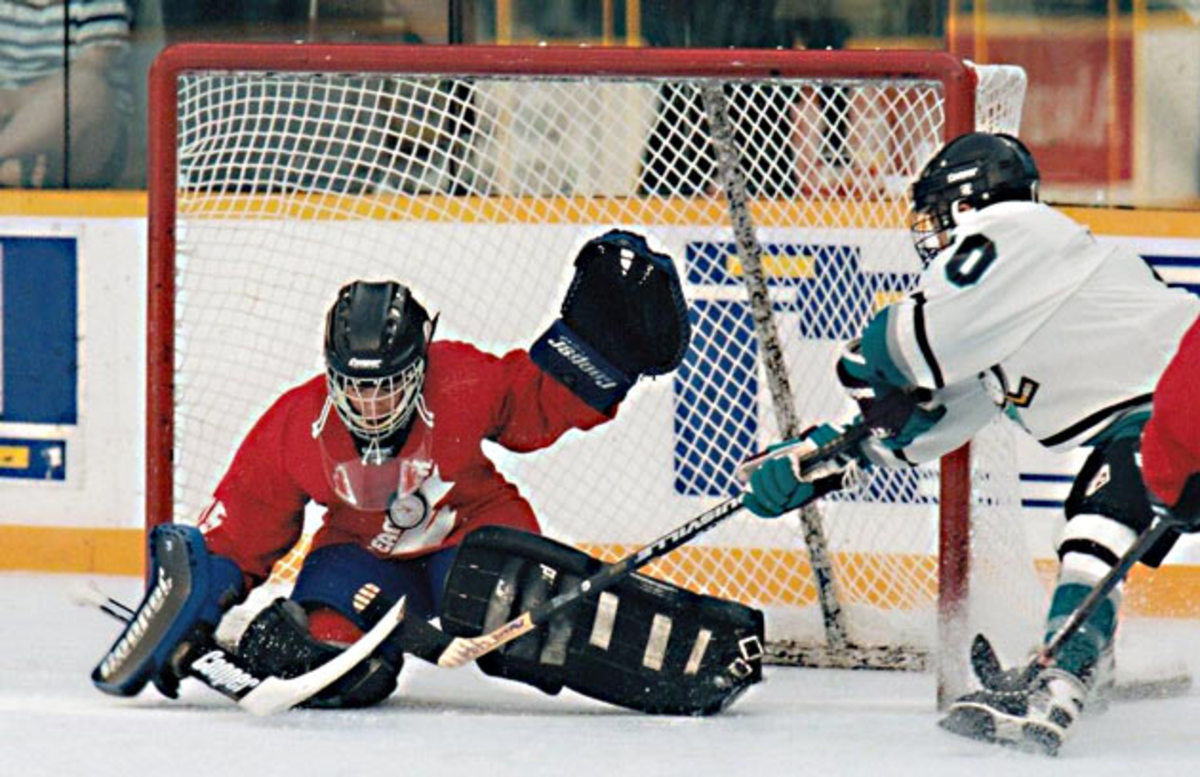
At 16, Szabados made headlines. That’s when she became the first female to play in the Western Hockey League, after catching the eye of a scout for the WHL’s Tri-City Americans while playing bantam in a major North American tournament in Calgary. Her first exhibition game with Tri-City was on the road against the Vancouver Giants during the 2002-2003 season. Coming off the bench, she relieved the team’s starter, now-Montreal Canadiens superstar goalie Carey Price.
“I went in and I let in my first shot,” she says, laughing. “It was a partial breakaway, and so I remember being pretty nervous about that, but I buckled down.”
Early life tragedy steeled Justin Faulk for rise to NHL stardom
Szabados got significant ice time with Tri-City in four preseason games. She then logged all of 20 seconds during the regular season before returning to Canada and breaking another barrier.
Back home, Szabados entered the Alberta Junior Hockey League. The first female to play in that league, she went on to earn All-League North Second Team honors during the 2004-2005 season as a member of the Sherwood Park Crusaders. Two seasons later, she was recognized as the league’s top goaltender while playing for Fort Saskatchewan. But her transition only got rougher.
The ugly words hurled from the stands didn’t stop when Szabados turned 16 and entered the all-male AJHL with the Sherwood Park Crusaders. One situation in particular on lasted years and stands out to both her and her father. Szabados played road games in Drayton Valley—a town in Alberta about 90 minutes southwest of Edmonton. There at the rink, an old man would sit up in the stands behind Szabados and tear into her every single time she played.
“He would just yell the most sexist things ever at me,” Szabados, now 29, says. “Every derogatory word you could ever think of. Literally everything.”
It got so bad that Szabados couldn’t concentrate. So, she told her father. At first, Gary told her that heckling was normal and that she’d have to get used to it. This wasn’t typical heckling, Szabados replied.
Things finally came to a tipping point during a game when Szabados was 19 and playing for the Bonnyville Pontiacs. Gary was at a game and noticed something unusual. His daughter kept turning around to look up at the old guy and a group of other fans. Their yelling was incessant.
• FUCHS: Jersey native Palmieri giving Devils his all in homecoming
Gary decided to walk over to the group and place himself in the middle of everything. They soon asked him what he was up to. Just watching the game, he told them. When the group told Gary he couldn’t stay in that area, he merely shrugged them off. Once their yelling resumed, Gary told the group to calm down. They didn’t like that. He says they then tried to get him out of the area. His wife came over. According to Gary, she was called a “bitch” and was threatened with being thrown over a railing by someone in the group if she didn’t leave. Security came by, wanting to know what was going on. After asking if security had heard what the group was calling his daughter, Gary says he was told to go back to his seat.
“Obviously, he knew what was going on,” Gary says about the security officer.
Before the end of her five-year career in the league, Szabados says coaches stopped playing her in Drayton Valley. The verbal abuse was too much.
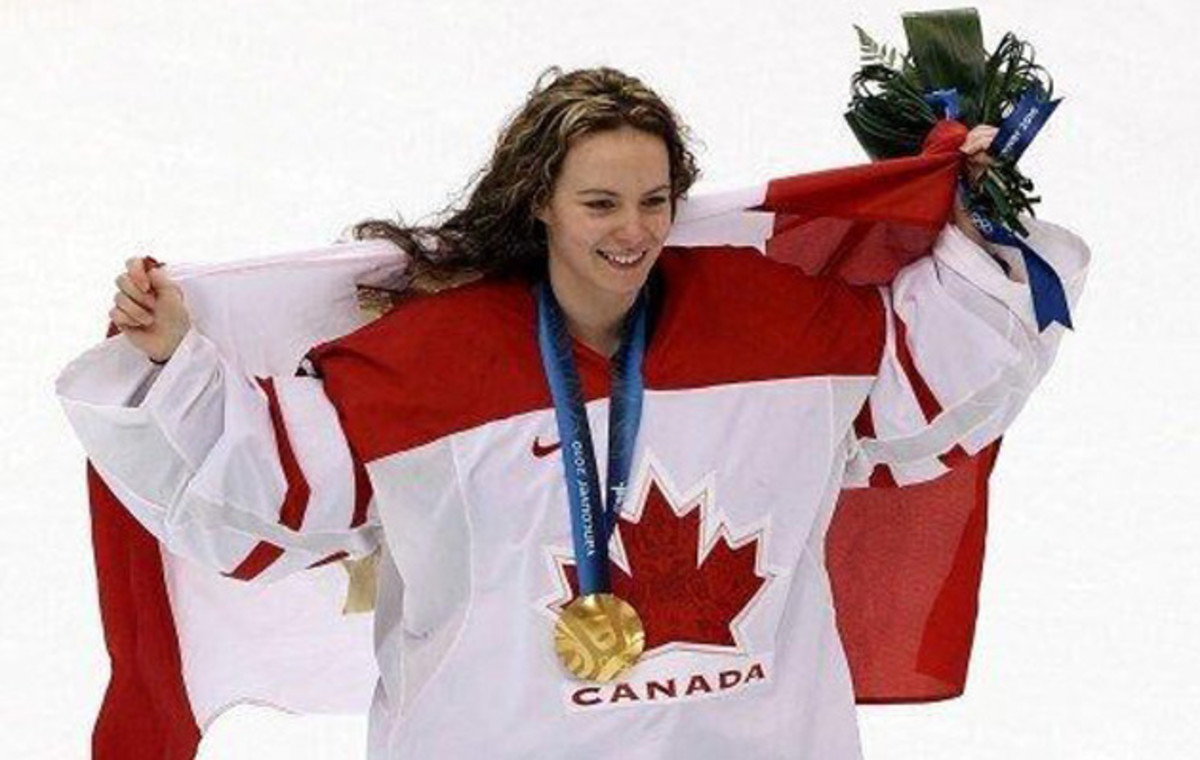
Despite all the adversity she faced, Szabados was added to the roster of Canada’s national womens' team in 2006 and she began a steady climb to prominence. In 2008, she was an alternate for her country at theInternational Ice Hockey Federation World Championship in China where Canada narrowly lost the gold medal game to Team USA, 4–3. Two years after that, the world’s two best womens' teams met up again, this time in British Columbia for the Winter Olympics.
Winter Classic a homecoming for Habs’ Mike Condon and his father
Vancouver’s energy was electric. The streets were packed. Canadians flooded them with anything and everything that sported their country’s colors.
Competing on her home soil in the 2010 Winter Olympics is something Szabados will never forget. It was the first time she had ever actually played on an Olympic team. It was also extremely nerve wracking.
The announcement came the night before the gold medal game. Szabados, the youngest of three goalies on Hockey Canada’s roster, would start against the United States.
Her mind raced after getting the news as she played out one scenario after another. She was about to play in not only first-ever Olympic gold medal game, but her first gold medal game for Canada in any major international tournament. And she wasn’t about to take to the ice the next day in front of just friends and family. Her whole country would be tuning in to watch, their hopes of Olympic glory—against their archrival to the south—resting on the rookie’s shoulders.
“You can’t mess this up,” a relatively sleepless Szabados thought to herself that night.
Szabados is the type of goalie who thrives on pressure, and she rose to the challenge the next day. In the zone, she stopped all 28 shots she faced and did her part in killing off Canada’s six penalties. Behind her play in the net and two first-period goals from teammate Marie-Philip Poulin, the Canadians beat the Americans, 2–0, to clinch the gold.
• VIEWFINDER: National Women's Hockey League
After the Vancouver Games, Szabados added the 2012 International Ice Hockey Federation World Championship’s gold medal to her collection. During the 2012-2013 season, after transferring from Edmonton’s MacEwan University she aided Northern Alberta Institute of Technology’s men’s team in winning the Alberta Colleges Athletic Conference crown. It was NAIT’s first ACAC championship in 16 years, and the team owed it in part to its first-ever female player. Szabados pocketed one more title—her second Olympic gold medal—in 2014 when she backstopped Team Canada in a come-from-behind overtime victory against Team USA at the Sochi Games.
After Sochi, an exhausted Szabados headed home for Edmonton. It had been a long, grueling year of training and competing with Hockey Canada. Now, it was finally time to get some rest. Well, at least that was the plan until her phone rang.
On the other end was someone from the Edmonton Oilers. It was March 4, 2014—the day before the NHL’s trade deadline. Edmonton told Szabados it was short a goalie. The team had shipped Ilya Bryzgalov to the Minnesota Wild and needed someone to fill in at practice the next day since incoming goalie Viktor Fasth—whom Edmonton received in a trade with Anaheim—wouldn’t be ready to go.
It was an once-in-a-lifetime opportunity for Szabados. There was one problem, though. Her stuff got lost coming back from Russia.
“I didn’t know what I was going to do, but obviously I couldn’t,” she says, pausing and chuckling. “I’m not going to be like, ‘No, I don’t have my equipment.’”
Luckily for her, everything worked out. Before she had to break out her old gear from her college days, her equipment showed up the morning of practice. Being with the team that day was quite an experience. Not only did she get to go up against NHLers, but she also got to be a fly on the wall and watch the league’s frenetic last-minute wheeling and dealing unfold from a completely different perspective.
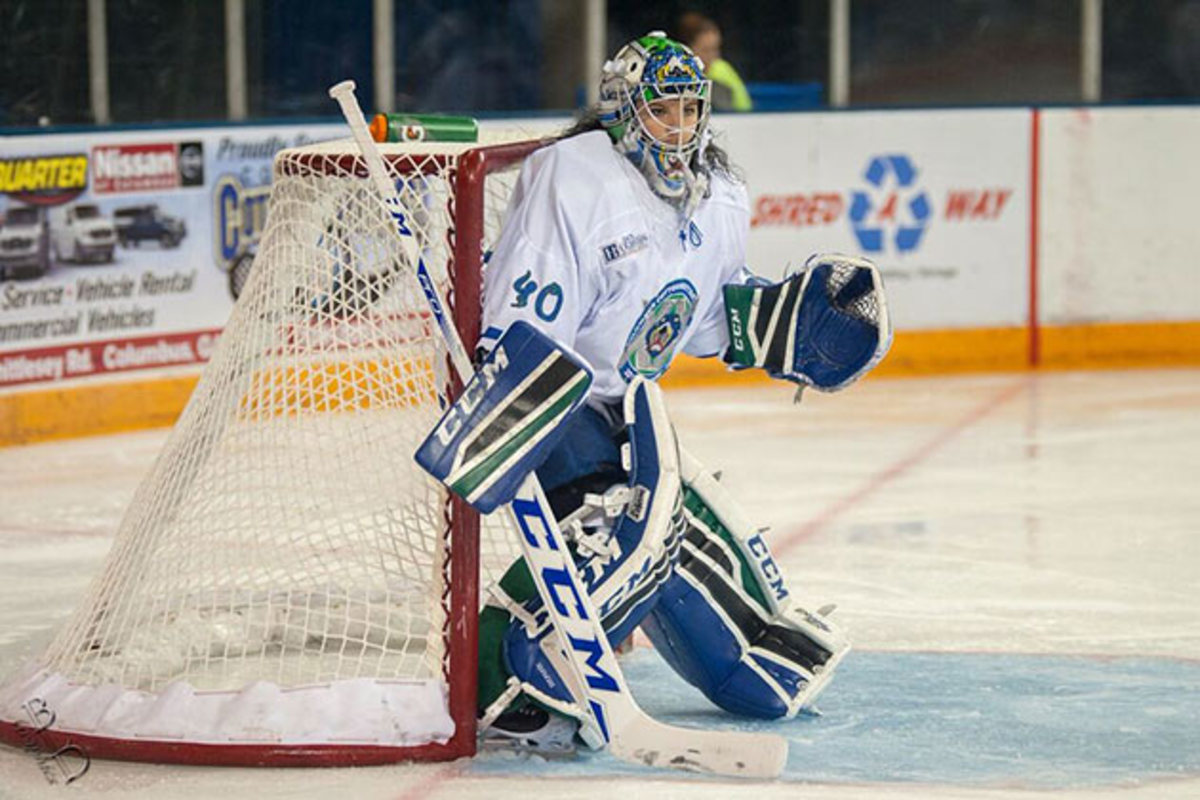
Men’s and women’s hockey are different games. The biggest difference, Szabados says, is the additional speed and strength that men have. This equates to harder shots flying toward the net and her playing more aggressively.
Women, she says, play a smarter game. Since they don’t have the same kind of strength that men do, women’s hockey is more oriented around puck possession and executing plays smartly. For example, take a two-on-one breakaway or a power play. A man might send a scorching shot at the net off a slap shot. A woman? She might look to score off a rebound or a deflection.
• What NWHL commissioner Dani Rylan has learned from Gary Bettman
“As a goalie, I almost have to clean up my game a little bit in the women’s game,” the 5' 9", 150-pound Szabados explains. “They go to the net a little bit more and try to create different things than the guys would.”
It wouldn’t be long after the Oilers practice that Shannon would be reminded again of these differences when she got another phone call. This time, it was from Georgia.
Around the time of the Oilers practice, a couple of Szabados’ old friends from her collegiate playing days at NAIT told her the coach of the Columbus Cottonmouths wanted to talk with her. The team down in the Southern Professional Hockey League wasn’t entirely foreign to her when she got the news. In fact, she started hearing from one of her friends about joining him on the team as early as Szabados’ final year in college.
Down in Columbus, head coach and general manager Jerome Bechard wasn’t completely happy with his once-clear goalie situation. Looking to make a change, he offered Szabados the opportunity to join the team.
She knew she had to take him up on the chance to play pro men’s hockey. Initially, she thought the invitation was for the following season’s training camp, but she grew somewhat hesitant when she found out that the offer was to immediately join Columbus for the final stretch of its season. Szabados didn’t want to go down there for a handful of games and make a bad first impression. She was worn out from her national team’s season. Also, aside from her one practice with the Oilers, she hadn’t really skated in the week or two after she got back from the Olympics. Plus, she’d just finished a year of playing women’s hockey and was unsure about how well she’d do immediately transitioning back to the style of hockey men play. After all, she remembered, she had a little trouble transitioning back to the men’s game after the 2010 Winter Olympics.
Szabados put those thoughts aside, though, and sent out a tweet on March 7, 2014, announcing that she was joining the Cottonmouths and would be with the team March 12.
“I’ll be honest with you,” Bechardsays. “I mean, if I didn’t do this to, one, get a little publicity, I’d be lying to you. But, two, just knowing that Kyle [Johnson, one of Szabados’ teammates back at NAIT] and these guys were putting a stamp on her, saying, ‘Hey, no, she’s legit. She can play,’ I wouldn’t have done it. I wouldn’t have put my neck out there.”
Bechard got the publicity he expected. What he didn’t expect at the press conference officially announcing Szabados’ arrival was the flurry of questions regarding when the team’s prized addition would actually play.
At first, Bechard planned on using Szabados on the road before the season came to close. Doing so would ease her into things and keep pressure off her. But then Bechard stepped back and swapped his coach’s hat for his general manager’s, realizing the impact his new female Olympian could have on home ticket sales.
Lined up in the hallway before getting onto the ice prior to her first start, Szabados felt the nerves and pressure her new coach wanted her to avoid. It was March 15, and the Cottonmouths were about to face the visiting Knoxville Ice Bears. That’s when one of her new teammates tapped her pads and offered a laugh.
“Just remember,” he said. “We all tie our skates the same way.”
Szabados giggled and agreed. She’d go on to stop 27 of 31 shots that night in a 4–3 loss.
One week later, she’d get the second start in her professional career. She lost that one, too.
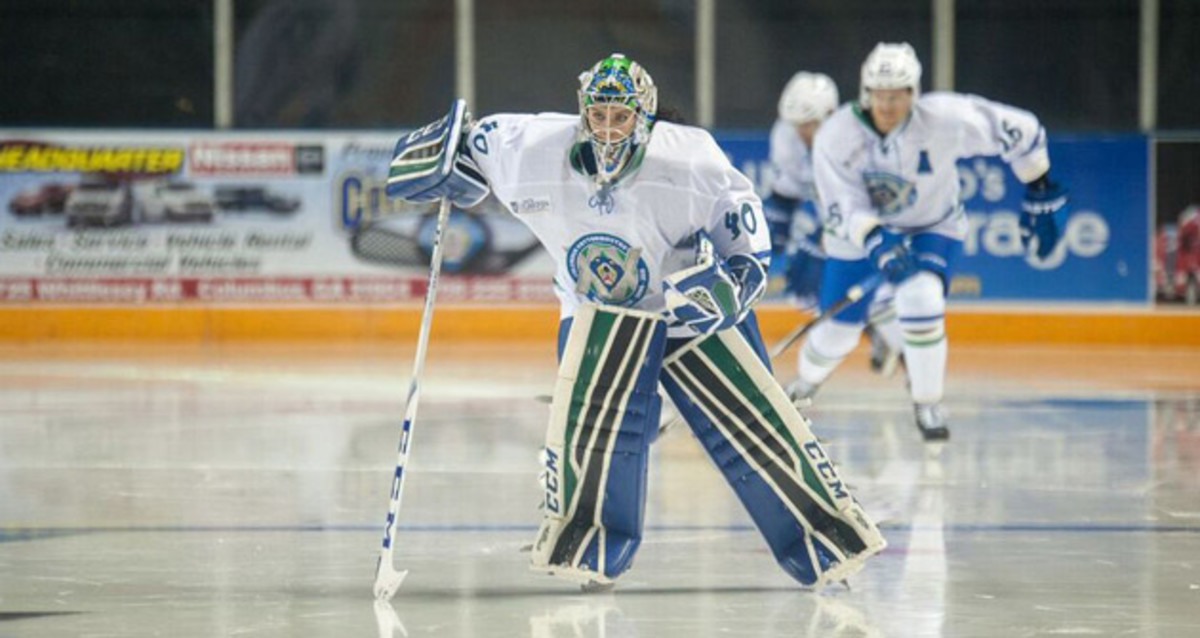
On Nov. 21, 2014, Szabados became the first woman to win a game in the SPHL. The win snapped the seven-game losing streak Columbus started the 2014-2015 season with and Szabados’ personal four-game skid dating back to her two-game stint with the Cottonmouths during the previous season.
It also was a huge relief. Prior to the win, Szabados felt like everybody was watching her, scrutinizing her. She wanted to prove that she wasn’t some novelty act.
Szabados finished her first full season in the SPHL with a 15-9-1 record. That came with a 3.12 goals against average and a .907 save percentage.
This season, Columbus endured another slow, rough start. The team returned just five players from the 2014-2015 campaign. There has been a slew of injuries, a player suspension and a player getting called up to the ECHL. Just like last year, seven quick losses piled up to start things off this autumn. With one game left before Christmas, Columbus sat in eighth place in its nine-team league.
Bechard saw his team’s slow start coming. However, he doesn’t blame it or last year’s rocky beginning on the Cottonmouths’ tandem of netminders.
Some of Columbus’ hometown supporters see things differently. They’ve told Bechard this season that the sideshow is over. It’s time to get rid of Szabados, they’ve said, and bring in an actual goalie and win games. He hears the criticism and takes it with a grain of salt, knowing the fans just want a winning team. Bechard tells them, though, the losses aren’t Szabados’s fault.
“It’s how we’re playing in front of her,” Bechard says. “I could have Carey Price in here, and we’d probably get the same results.”
Fans don’t stop at Bechard. Szabados sees stuff on social media. There, she’s read posts saying that her time down in Georgia is just one giant publicity stunt by the team.
“She’s under the microscope every single day,” Bechard says. “The biggest reason is because she’s a woman playing a man’s sport.”
Then there are the fans who cheer on the SPHL’s northern teams. Szabados says about 10 percent of them single her out, spewing disgusting remarks at her. She stays mentally tough when she hears these remarks, though, crediting her time in the AJHL and having to play in front of that sexist, foulmouthed old man in Drayton Valley during her teenage years with steeling her concentration and emotions.
It was getting late on a Wednesday night in mid-December when Szabados got back from the local mall. She and her Columbus teammates had just finished showing off the ugly Christmas sweater jerseys that they were going to play in that weekend.
Back at the small, log lake house cabin she’s staying at this season, she sat on a stool in the common room near the door to her deck. She talked about her roommate—her pet turtle Leo, named after her favorite Ninja Turtle character—and about how a cup of coffee from McDonald’s in Georgia isn’t the same as one from her beloved Tim Hortons back home in Edmonton and what might happen next in her ongoing hockey journey.
Player contracts are a year-to-year thing in the SPHL. Szabados won’t make a decision about where she’ll play next season until the summer. If she has her way, though, she’ll be back down here. After that, it’s an Olympic year, and the chance to turn two consecutive gold medals into three. A year playing in the recently created National Women’s Hockey League could follow. Szabados would be 32 by then. She doesn’t know for sure how much longer she’ll play, but caps it probably at 32. It depends on how her body holds up.
What happens after that?
“I don’t know, to be honest,” she says. “I would like to stay in the game somehow.”
